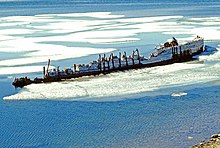Maud (ship)

| |
| History | |
|---|---|
| Name | Maud |
| Namesake | Queen Maud of Norway |
| Owner | Roald Amundsen |
| Builder | Built in Asker, Norway |
| Launched | June 1916[1] or 17 June 1917[2] |
| Owner | Hudson's Bay Company |
| Acquired | 1925 |
| Renamed | Baymaud |
| Owner | Asker, Norway |
| Acquired | 1990 |
| Renamed | Maud |
| General characteristics | |
| Class and type | Oak hulled sailing ship, built for Arctic exploration |
| Tonnage | 292 register |
| Length | 36.5 m (119.75 ft) |
| Beam | 12.3 m (40.35 ft) |
| Depth of hold | 4.85 m (16 ft) |
| Propulsion | 240 hp (177 kW) semidiesel Bolinder engine |
Maud, named for Queen Maud of Norway, was a ship built for Roald Amundsen for his second expedition to the Arctic. Designed for his intended voyage through the Northeast Passage, the vessel was built in Asker, a suburb of the capital, Oslo.
Maud was launched in June 1916[1] or 17 June 1917[2] at Vollen and ceremonially christened by Amundsen crushing a chunk of ice against her bow:
It is not my intention to dishonor the glorious grape, but already now you shall get the taste of your real environment. For the ice you have been built, and in the ice you shall stay most of your life, and in the ice you shall solve your tasks. With the permission of our Queen, I christen you Maud
— Roald Amundsen[1]
Career and fate

She lived up to her christening, as she remained in the ice until 2016. Whereas other vessels used in Amundsen's polar explorations, Gjøa and Fram, have been preserved at the Norwegian Maritime Museum, Maud had a more rugged fate. After sailing through the Northeast Passage, which did not go as planned and took six years between 1918 and 1924, she ended up in Nome, Alaska and in August 1925 was sold on behalf of Amundsen's creditors in Seattle, Washington.
The buyer was the Hudson's Bay Company, which renamed her Baymaud. She was to be used as a supply vessel for Company outposts in Canada's western Arctic. Prior to her final voyage Baymaud was given a refit in Vancouver, British Columbia. (The work was supervised by Tom Hallidie, who later went on to design the RCMP vessel St. Roch, based on Maud.) In the winter of 1926 she was frozen into the ice at Cambridge Bay, where she sank in 1930. The wreck now lies just offshore, across the inlet from the communities former Hudson's Bay Company store. Nearby is the site of the former Cambridge Bay LORAN Tower, built in 1947.
In 1990 the ship was sold by the Hudson's Bay Company to Asker with the expectation that she would be returned to the town. Although a Cultural Properties Export permit was issued, the price tag to repair and move the ship was 230 million kroner ($43,200,000) and the permit expired.[3][4][5]

In 2011 Norwegian company Tandberg Eiendom AS in the project Maud Returns Home[6] announced a plan to return Maud to Norway. They intend to build a museum in Vollen to house her, near where she was built. They claimed to have purchased a barge to move her. Concern about the plan has come from the community of Cambridge Bay, Parks Canada, the Government of Nunavut, the International Polar Heritage Committee, and some people in her intended destination. Moving the ship would require another export permit from the federal government.,[7] which it declined to issue, on grounds of a lack of "a full archeological study".[8] The decision was reversed on appeal in March 2012.[6][9] The salvage operation was under way in the summer of 2015, with a plan to return the hull to Norway in the summer of 2016.[10]
On 31 July 2016 it was reported that the hull of Maud had been raised to the surface in preparation for shipment to Norway, perhaps in 2017. [11]
References
- ^ a b c Unsinking a ship: Maud returns home - Roald Amundsen and Maud
- ^ a b Maud Returns Home
- ^ Underwater Treasure of Cambridge Bay
- ^ Nunavut News/North Monday August 20, 2007 "Saving the Maud"
- ^ Cambridge Bay, Prince of Wales Northern Heritage Centre (1996)
- ^ a b Maud Returns Home
- ^ Norway wants Amundsen’s Maud back from Nunavut
- ^ Ottawa nixes export permit for Maud
- ^ Norwegians set to repatriate Maud after reversing export permit refusal
- ^ Project Website
- ^ CBC News: The Maud floats again: Norwegians bring long-sunken ship to surface
External links
- Maud at the Fram Museum
- Maud Template:No icon - Photos
- Arctic exploration vessels
- Individual sailing vessels
- 1916 ships
- Ships built in Norway
- Tall ships of Norway
- Asker
- Sailing ships of Canada
- Kitikmeot Region
- History of Nunavut
- Shipwrecks of the Canadian Arctic coast
- Art and cultural repatriation
- Maritime incidents in 1930
- Hudson's Bay Company ships
- Icebreakers of Norway
- Icebreakers of Canada
